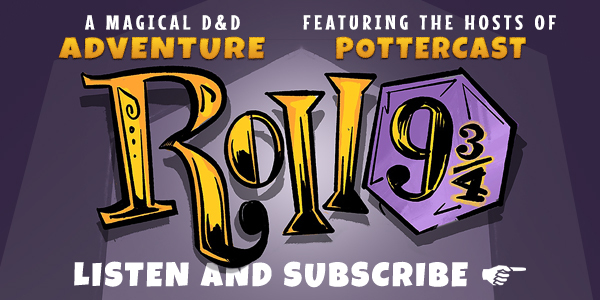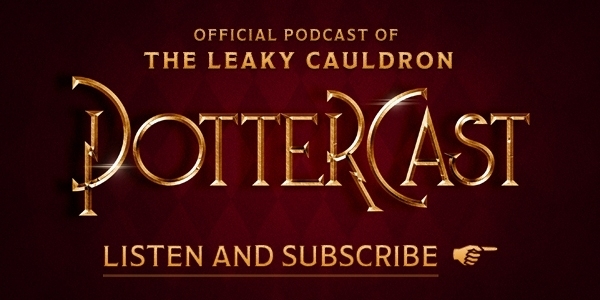The Actual Chess Endgame in the Harry
Potter and the Sorcerer's Stone Movie
Written by Jeremy Silman1
Essay adaptation for Scribbulus
written by WizBang101
Imagine you have just seen your first Harry Potter movie, Harry Potter and the Sorcerer's Stone. It was exciting and very dramatic, especially the scene of the chess game where Ron sacrificed himself so Harry could checkmate the White King. If you are familiar with the rules of chess, however, the movie scene doesn't make sense. This is because vital information was cut from the final version of the movie.
Recall from the movie, Harry, Ron, and Hermione play their way across a chessboard to pass the White players in a giant-scaled and dangerous game of Wizard Chess. In order for our heroes to pass, they have to play deadly moves as Harry, Ron, and Hermione are part of the Black pieces as a Bishop, Knight, and Castle (Rook). Many chess pieces are smashed into bits when they are overtaken by the opponent pieces. We find that in the last moves, Ron, as a Knight, has manoeuvred himself to the edge of the board as a forced sacrifice to the White Queen, since he has checked the White King. After Ron's sacrifice, Harry reminds Hermione not to move until Harry, as the Black Bishop, moves into a position to checkmate the White King, as per Ron's game plan.
After watching the action-packed scene again, I noticed that something didn't quite add up. Why did Ron need to sacrifice himself when it seems that Harry could have moved in an apparent checkmate instead? If the Queen had just taken out Ron on the edge of the chessboard, why wasn't she able to prevent the checkmate in the middle of the board? Confused? Of course you are, and you are not the only one. Perhaps, like me, you repeatedly watched the scene and found that the whole last movement of the chess pieces made absolutely no sense.
It is fortunate that the actual endgame itself was, in fact, well constructed even though several key moves were cut from the final version of the movie. This explains why what we end up seeing makes little sense to people who know the rules of chess. The additional moves that were cut tell an even more exciting story. Behind the scenes, and sadly not credited for the famous chess scene, was International Master Jeremy Silman. Below, he explains the actual complete chess positions and chess movement created by himself for Ron's endgame in the Harry Potter and the Sorcerer's Stone movie, but first I will introduce Jeremy Silman and provide some quick notes about chess notation.
Introducing IM Jeremy Silman
Firstly, to those people who don't understand what an International Master (IM) is in
chess, an IM is a lifetime title that rewards outstanding players. There is an
even higher title, the Grandmaster (GM). An IM is usually in the top 0.25% of
all tournament players at the time of the title being conferred. As a
comparison, a GM is usually in the top 0.02% of all tournament players. An IM
must either achieve three favourable results in highly rated tournaments that
involve IMs and GMs or they receive the title for a specific outstanding
performance in an overwhelmingly strong tournament.
IM Jeremy Silman has won the American Open, the National Open, and the U.S. Open. Very few players have won all three prestigious events. However, Mr. Silman is better known as a lecturer, teacher, and author of over thirty-five chess books plus a book on psychological gambling called Zen and the Art of Casino Gaming. Maxwell/Macmillan, Cadogan, and Microsoft Press published Silman's books and many have been translated into German and French. In addition, English, Dutch, German, and American magazines have featured over one hundred chess articles written by Silman.
In 1994, Silman started to write fiction and created his first screenplay (optioned by
LMK Productions, Inc) called The Chess Players. In 2001, Silman was
hired as the chess consultant for the motion picture Harry Potter and the
Sorcerer's Stone. Other projects include being a chess consultant for the
HBO series Arliss and designing multiple chess scenes for an episode of Malcolm
in the Middle.
How chess notation is written2
Chess games and positions are recorded using algebraic notations. Each square of the
chessboard is represented from left to right, the letters a to h (files), and
from bottom to top, the numbers 1 to 8 (ranks), using the view from the white
pieces.
Movement of the chess pieces are recorded in typical format of:
1. abbreviation of the piece moved
2. file where it moved
3. rank where it moved,
For example, Qg5 means "Queen moves to the g-file and 5th rank (square g5)."
If the piece makes a capture, x is inserted behind the abbreviation of the piece name,
e.g. Bxf3 means "Bishop captures on f3." A move which places the opponent's
King in check usually has the notation + added. Checkmate can be indicated by
#. Chess moves can be annotated with punctuation marks and other symbols. For
example, ! indicates a good move, !! an excellent move, ? a mistake, ?? a
blunder, !? an interesting move that may not be best, or ?! a dubious move, but
not easily refuted.
In writing the moves, it goes in this sequence: the move number, the abbreviation
for White's move and then the abbreviation for Black's move. For example, 25.
Qg5, Nxd4 is the 25th move and White's move was Queen goes to square
g5 and Black's move was a Knight that took a piece on square d4.
Now we go onto IM Jeremy Silman's detailed description of how his plan for an exciting
endgame for the Sorcerer's Stone movie was suppose to be.
Harry Potter, the Complete Position,3 by IM Jeremy Silman
When I was asked to create the chess positions for Harry Potter and the Sorcerer's
Stone, I was more than delighted. Throughout my life, I've watched movies
and TV shows make a joke of real chess positions and real chess lingo. Now,
after years of seething, I finally had a chance to do the job right...
When I read the first Potter book and was faced with the problem at hand: What
position would I create that would justify Ron sacrificing himself? After
spending many hours ’ day after day for a few weeks ’ on the phone to the screenwriter
in Los Angeles and the producer in England (who insisted that the first move
should be a capture), I finally decided on the following dynamic situation:
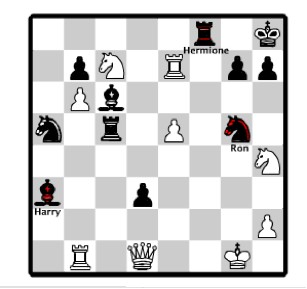
Black has lost his Queen, but he has a strong attack against the White King.
Black's immediate threat is 1...Nh3 mate, so White begins with...
1.Qxd3
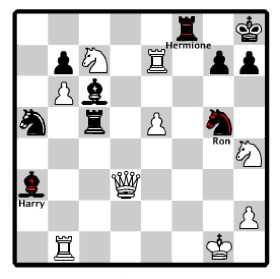
1...Rc3!
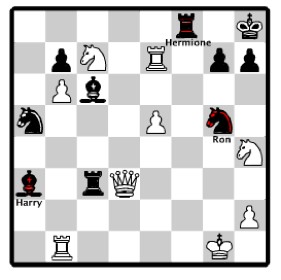
the audience. The real point, of course, is that it frees the c5-square for the
Harry-Bishop.
2.Qxc3

for our heroes, but is this really true? Note that I created a logic problem
here. Black can force a mate in two moves, but that would NOT be the correct
solution. Can you figure out why?
2...Nh3+!
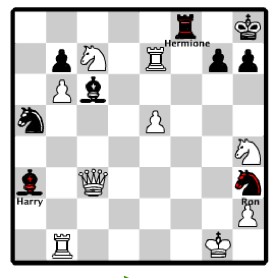
sacrifice of HARRY, something that would end the quest immediately and is
therefore completely unacceptable. By sacrificing himself, Ron pulls the Queen
away from its control over the c5-square.
3.Qxh3
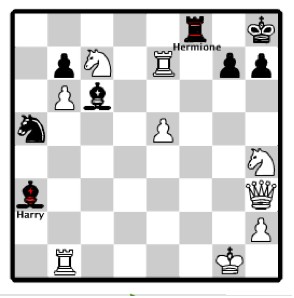
3...Bc5+
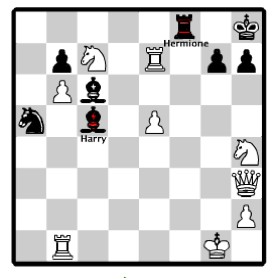
effort to safe its Monarch.
4.Qe3
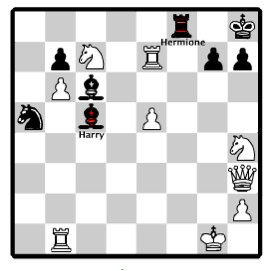
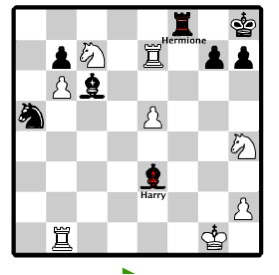
enormous amount of emotional satisfaction with Harry's conquest of the hateful
Queen.
Unfortunately, movie dynamics once again turned a well thought out chess situation into
mumbo-jumbo (though it looked very energetic on the big screen). The length of
the film demanded some cuts, so the moves of this whole scene were more or less
slashed to ...Nh3+ (Ron's sacrifice) and ...Be3 mate (notice that ...Be3 doesn't capture the Queen...very, very sad.) I still feel that this was a real missed opportunity and would have enriched the whole on-screen scene immeasurably.
Conclusion
Jeremy Silman's description of the endgame paints a very graphic and thrilling scene.
The endgame was originally intended to make a villain of the White Queen as
well as showing the mortal danger that Harry was under during this time. The
sacrifice and forced moves were deemed necessary to emphasize the dramatic
uncertainty our heroes were under. The movie scene, however, loses the suspense
of the game.
Perhaps we can conclude that the media format of movies will never tell the full story
that a book portrays because of the time constraints of a two-hour film as well
as the lack of expedient explanations to keep the tempo of the story moving.
The end result of using the movie format to explain the story is that it loses
that extra deep and meaningful understanding, as well as missing parts of the
tale.
Rowling's original presentation in the book is recreated into another person's
interpretation on the screen (namely the director's interpretation) therefore
leaving the audience to fill in the missing gaps. Although the chess scene was never
detailed in the book, it needed a correct screen presence. Such
well-constructed details can be reduced to nonsense after the editing process.
This goes to show that in the movie, Rowling's presentation of the story is
shortened and the plot and the sub-plots of the tale are also made into
"mumbo-jumbo" for the member's of the audience who have not read the book.
The essence of the book, and the chess scene that was carefully constructed by IM
Jeremy Silman, lost the richness of the Harry Potter experience when
converted for the movie audience. The chess moves designed for this story were
meant to tell a hidden story of their own that symbolised the larger struggle,
but was lost in editing to become "mumbo-jumbo." Although the final movie scene
was appreciated for its dramatic action, it fails to portray chess strategy
(and to fully recognize Ron's intellect) and so loses a chance at inspiring
many Harry Potter fans to pick up chess to stimulate their minds.
Stories such as those told in the Harry Potter books cannot be replaced by the
movie interpretation and there are always some gaps even in the book itself
that would be lost or open to anyone's interpretation. But what we see is that
some gaps do not have to be lost, but it is rather a time of lost opportunities
that could add more to the experience. The chess endgame in the movie Harry
Potter and the Sorcerer's Stone is one such missed opportunity.
Notes
1. Copyright © 2002 Jeremy Silman. Used with permission and adapted for the Leaky Lounge and Scribbulus by WizBang 101.
2. Wikipedia, s.v. "Chess."
3. Silman, "Harry Potter, the Complete position."
Bibliography
Harry Potter and the Sorcerer's Stone. Directed by Chris Columbus. Burbank: Warner Bros. Pictures, 2001.
Silman, Jeremy. "Harry Potter, the Complete position." WWW.JEREMYSILMAN.COM: Exploring the world of chess, movies, and beyond. 2002. http://www.jeremysilman.com/movies_tv_js/harry_potter.html (accessed on January 30, 2009).
”””. Zen and the Art of Casino Gaming. Summit Pines Press. 1996.
Wikipedia: The Free Encyclopedia, s.v. "Chess." http://en.wikipedia.org/wiki/Chess (accessed on January 30, 2009).
Comments? Discuss this essay and vote for the Readers' Choice Award on the Scribbulus forum.

